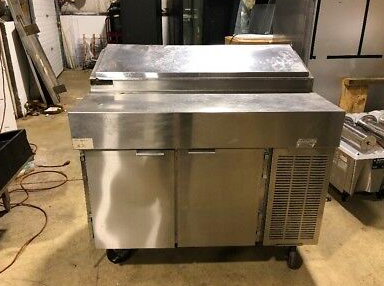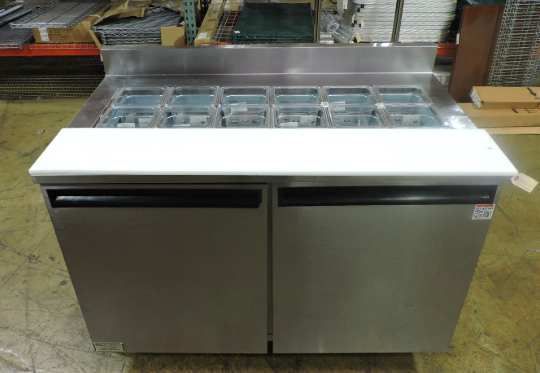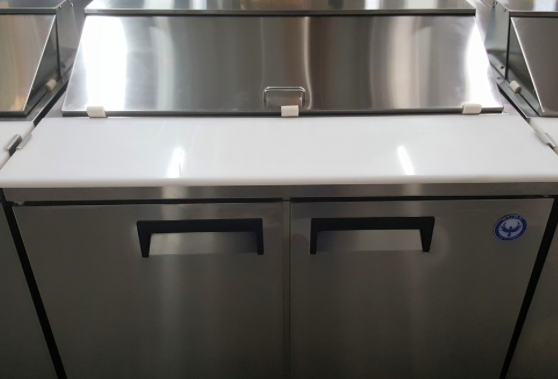When it comes to speed, convenience, and food safety, you have to stand in awe of the commercial sandwich prep table, arguably one of the hardest-working and most-accessed pieces of equipment in any commercial kitchen. Available in a wide range of sizes, from single-door units to massive three, four, or five door units that can reach lengths of six feet or greater, commercial sandwich prep tables are versatile pieces of equipment that can be used in a variety of different ways.
Browse our full inventory of used commercial sandwich prep tables below. Each prep table is listed by the owner of the unit. We don’t take commissions or fees so you can get the best price possible on used restaurant equipment.
[display_listings l_type=”86″]
Though designs vary somewhat, most units feature a lower refrigerated compartment, with a flip-top design that provides refrigerated storage for prepped ingredients, such as sliced cheese, tomato, onion, and shredded lettuce, condiments including sauces and relishes, cooked proteins including chicken strips or bacon, or finishing elements, like parsley, sliced lemon or chopped nuts. In essence, any component of your dish that you use frequently enough to try and avoid going in and out of the reach-in hundreds of times, can find a place in the top of a refrigerated commercial sandwich prep table.
Most units allow for a variety of configurations in the top flip-up portion, allowing you to place any combination of 1/6, 1/3, or even 1/2 sized prep pans. This allows you to devote more space to large pans for items you use more frequently, or which are prone to running out during service.
Though you definitely sacrifice some usable work space on top of the unit, thanks to the space needed for the refrigerated prep pans, being able to access ingredients quickly and safely makes up for the lost real estate. Most commercial refrigerated sandwich tables include a removable, washable cutting board, making it easy to slide your plate or to-go box along the length of the unit, adding ingredients as you move down the line.
How Do You Use a Commercial Sandwich Prep Table?

You can use a commercial sandwich prep table in a variety of ways. The most common use is for the preparation of hot or cold sandwiches (hence the name of this type of equipment. The sandwich assembler will start at one end of the unit with a sub roll, for example, and then access the refrigerated top for the different ingredients needed to build the sandwich, scooting the bread along the front rail as they work their way down the line. Lettuce, tomato, cheese, meat, olives, mayonnaise, mustard…they can all be accessed easily, with only a minimal increase in temperature for the ingredients within. After the sandwich is built, the top is swung closed, to protect the ingredients from warm air or other contaminants.
But sandwich prep tables aren’t limited to making sandwiches. They’re also often employed in a restaurant’s “cold station,” where salads, cold appetizers, and similar foods are prepared. In this case, the refrigerated top pans would be filled with prepped lettuce, tomatoes, sliced cucumbers, assorted dressings, and anything else that might be included on the plate.
Some restaurants even employ commercial sandwich prep tables outside of the kitchen, wheeling the entire unit into a dining or pickup area, where customers can help themselves to additional toppings. This is ideal for topping-heavy restaurant concepts, such as burger restaurants or Mexican restaurants, where customers can add various additional sauces and vegetables to their dishes. The refrigerated bulk storage below makes it easy to store ready-to-go backups of the items in the self-service area, so that when one particular item gets used up, it’s easy for a staff member to swap in a new prepped pan of a particular topping, without making multiple trips back and forth to the kitchen.
How to Evaluate a Used Commercial Sandwich Prep Table

As with any kitchen item that’s prone to hard use and abuse, evaluating a used commercial sandwich prep table requires some special considerations. When evaluating a unit for potential purchase, begin by examining the overall cosmetic condition of the sandwich prep table. Is the stainless steel scratched up? Are there dents in the doors? Does the swivel top stay open when it’s supposed to, a swing smoothly closed? Are all four feet or casters still present on the unit? While none of these impede the function of a used commercial sandwich prep table, they can tell you a lot about how well the unit was treated, and how long it was in use. If the front door of the unit has a huge dent that’s suspiciously the size of a line cook’s foot, or the sides of the unit are covered in rust and grime, it’s a safe bet that the equipment wasn’t treated with the respect it deserved. And if the outsides were beaten on, chances are, the insides were pretty heavily neglected as well.
The next major question you’ll need to have answered is whether the unit is reliably and consistently maintaining an internal temperature of 40 degrees or colder. Keep in mind that these types of refrigerators operate at peak efficiency when the top prep area is loaded with pans; a sandwich prep table with an empty prep top is probably losing lots of cold air and efficiency through the swivel prep lid, which isn’t insulated and typically doesn’t make a tight seal with the body of the unit. Check the temperature of both the main storage compartment of the refrigerator, and the top prep area to make sure that food can be held at safe, cool temperatures.
Ask your seller if anything else is included in the sale. Many vendors will throw in a few 1/6 pans to fill the top prep area, along with the steel rails needed for different pan configurations. If these aren’t included, it shouldn’t be a deal-breaker, but remember that purchasing a few dozen prep pans will add to your cost. While you’re at it, check to make sure that the unit has all of its original shelves, and if not, find out how expensive it will be to replace them.
Listen carefully to the compressor. You’ll want to be on the lookout for any unusual noises, or the sound of metal rubbing against metal, which may indicate an issue with the compressor fan, which can eventually lead to compressor failure, ice buildup, or worse, the loss of your inventory. Ask the seller if there are any known issues with the thermostat or the unit’s defrost cycle, and if the unit is running, check for ice buildup both inside and outside the unit, as well as the presence of any water that could indicate condensation problems.
Try not to worry about the overall cleanliness of the unit. Not every chef or owner is as meticulous as they should be about cleanliness. While we’d all love to be able to buy a unit that’s ready to place in the kitchen (or at the very least, doesn’t have a decaying mouse crammed in its drain), everything can be cleaned. We’ve seen some truly disgusting commercial sandwich prep tables brought back to life with just a few hours of elbow grease (and some truly toxic cleaning products). If the unit you’re looking at seems particularly grubby, try using that as a negotiating point, to get a few dollars knocked off the price.
How to Integrate a Used Commercial Sandwich Prep Table into Your Kitchen

Placement of your brand new (to you!) commercial sandwich prep table into the existing workflow of your kitchen is going to be a matter of personal preference and the needs of your restaurant. If you’re using it for sandwiches, placing the unit near the front of the house or near the cash register may make the most sense; after all, customers love watching their sandwiches get made, for some reason.
If you’re using the sandwich prep table in another station in the kitchen, such as for appetizers or salads, it may make sense to separate that station from the rest of the kitchen (ideally with a separate ticket printer, which fires just on that station). Remember, these units are designed to make it easy to access the ingredients you use most often, so place it within your kitchen accordingly.
